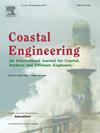计算高能近岸波:弱色散相位分解模型是否讲述了同样的故事?
IF 4.2
2区 工程技术
Q1 ENGINEERING, CIVIL
引用次数: 0
摘要
在夏威夷瓦胡岛北岸 Haleʻiwa 附近,使用了三个相位分解弱色散波模型,对高能海平面 (SS) 强迫诱发的大规模逐波过程进行了 2DH(二维深度积分)计算。将计算出的模型结果与在近岸横礁横断面和小船港盆地获得的观测结果进行了比较。对港湾内和礁石上的频谱分析表明,这三种模式都能解释次重力(IG)空间模态结 构,与观测结果以及边缘波和漏波理论相一致。在礁石上,自谱和横谱分析表明,三种模式都能定性地再现主要波形,具体表现在:(i) 从深水区到浅礁区的次重力波振幅增长;(ii) 近岸位置的功率谱密度峰值一致;(iii) 模式之间以及模式与观测结果之间的空间相干函数具有显著的相似性。对进入哈雷伊瓦小船港的涌浪的计算表明,模型可以成功地再现窄 IG 频带的变化,这些频带与空间有关,并经常受到共振放大的影响。本文章由计算机程序翻译,如有差异,请以英文原文为准。
Computations of energetic nearshore waves: Are weakly dispersive phase-resolving models telling the same story?
Three phase-resolving weakly dispersive wave models are used for 2DH (2D depth-integrated) computations of large-scale wave-by-wave processes induced by highly energetic sea/swell (SS) forcing near Haleʻiwa on the North Shore of Oʻahu, Hawaiʻi. The computed model results are compared to observations obtained over a nearshore cross-reef transect and from the basin of a small boat harbor. The level of agreement between the model results and observations in complex coastal environments under highly energetic wave forcing, along with the qualitative consistency among the three models, makes these models good candidates for operational applications in nearshore environments exposed to energetic wave forcing conditions.
Spectral analyses inside the harbor and over the reef indicate that all three models generally account for infragravity (IG) spatial modal structures that are consistent with observations and the theory of edge and leaky waves. Over the reef, auto- and cross-spectral analyses reveal that the dominant waveforms are qualitatively reproduced by all three models, as indicated through: (i) the growth of IG wave amplitudes from deeper water to the shallow reef sites; (ii) the agreement of power spectral density peaks at the nearshore locations; and (iii) the remarkable similarity of spatial coherence functions among the models and between the models and observations. The computations of swell entering the small boat harbor at Haleʻiwa demonstrate that the models can successfully reproduce the variability in the narrow IG frequency bands that are spatially dependent and often subject to resonant amplifications.
求助全文
通过发布文献求助,成功后即可免费获取论文全文。
去求助
来源期刊

Coastal Engineering
工程技术-工程:大洋
CiteScore
9.20
自引率
13.60%
发文量
0
审稿时长
3.5 months
期刊介绍:
Coastal Engineering is an international medium for coastal engineers and scientists. Combining practical applications with modern technological and scientific approaches, such as mathematical and numerical modelling, laboratory and field observations and experiments, it publishes fundamental studies as well as case studies on the following aspects of coastal, harbour and offshore engineering: waves, currents and sediment transport; coastal, estuarine and offshore morphology; technical and functional design of coastal and harbour structures; morphological and environmental impact of coastal, harbour and offshore structures.
 求助内容:
求助内容: 应助结果提醒方式:
应助结果提醒方式:


